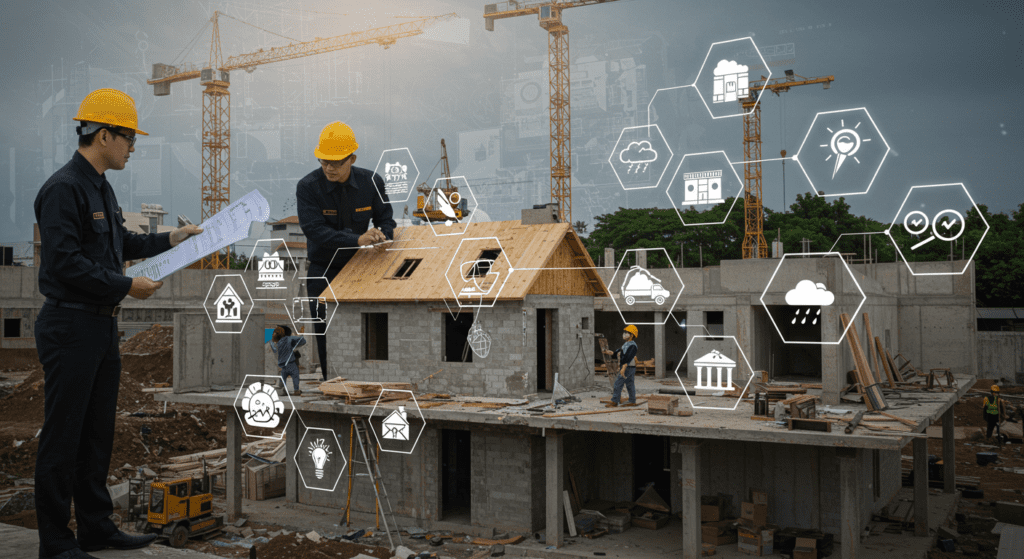- Assessing Risks in Homebuilding Projects
- Essential Policy Options for Developers
- Liability and Risk Management Strategies
- The Role of Certifications in Insurance
- Navigating the Claims Process for Homebuilders
- Tips for Negotiating with Insurers
- Insurance Considerations for Multi-Unit Developments
- Emerging Trends in Construction Risk Management
- Future Proofing Your Insurance Portfolio
Construction insurance is an essential safety net for anyone involved in the homebuilding industry. It provides protection for both developers and homeowners against unforeseen events and risks that could potentially lead to significant financial losses. Understanding construction insurance basics means knowing the types of policies available and how they work to guard against unforeseen events such as property damage, theft, or accidents during the construction process.

1. Assessing Risks in Homebuilding Projects
When embarking on a homebuilding project, one of the first steps is to thoroughly assess the risks involved. Developers must identify the potential hazards related to location, design, materials, and even labor practices. External factors such as weather patterns, natural disasters, and even local regulations can play a significant role in framing risk. Evaluating these challenges allows developers to choose appropriate insurance coverage that specifically targets the array of risks inherent in their projects. This proactive approach in risk identification not only fortifies the financial stability of the project but also instills a culture of safety and preparedness throughout the construction process.
2. Essential Policy Options for Developers
Developers have access to a wide range of policy options designed to cover various stages and aspects of construction. General liability insurance, for example, is fundamental in safeguarding against bodily injury or property damage claims resulting from construction activities. Builder’s risk insurance is tailored to cover damage to structures under construction. In addition, professional liability insurance might be necessary to protect against claims arising from design or engineering errors. Choosing the right mix of policies is critical; effective insurance coverage should address both common and unique risks associated with each specific project. Developers must work closely with their insurance brokers to tailor policies that can accommodate the dynamic needs of evolving construction projects.
3. Liability and Risk Management Strategies
Efficient liability and risk management strategies are key to minimizing potential losses on construction projects. Incorporating comprehensive safety protocols, training programs, and regular site inspections helps in reducing the occurrence of accidents. A well-defined risk management plan includes preventive measures, rigorous quality control, and contingency planning. In addition to implementing these tangible strategies, maintaining open lines of communication between contractors, subcontractors, and insurers is vital. Regular review meetings can ensure that everyone involved stays informed about potential risks and mitigation strategies. Incorporating these measures helps to build trust among stakeholders and minimizes the chance of liability claims escalating into longer, more complicated disputes.

4. The Role of Certifications in Insurance
Certifications play a pivotal role in obtaining favorable insurance terms and rates. Contractors and developers who take the initiative to secure professional accreditations signal their commitment to excellence and safety standards. These certifications, often issued by recognized professional bodies or government agencies, can help reduce insurance premiums by providing measurable evidence of competence and risk mitigation. Insurers frequently view certifications as a form of due diligence, reducing overall exposure to claims. When developers invest in certification programs, it not only improves operational standards but also reinforces the credibility of a project in the eyes of insurers and potential clients.
5. Navigating the Claims Process for Homebuilders
An efficient and well-structured claims process is essential for homebuilders to recover quickly from disruptions. Navigating the claims process requires an understanding of your policy terms and conditions, as well as a proactive approach to reporting incidents. When an incident occurs, prompt communication with the insurance provider can make a significant difference in the speed and effectiveness of claim resolution. Homebuilders should maintain detailed documentation of events, including photographs, incident reports, and witness statements. Assembling this evidence eases the claims process and minimizes potential disputes. Familiarizing oneself with the procedures set forth in the policy ultimately ensures that claims are handled with maximum efficiency, reducing downtime and focusing on project recovery.
6. Tips for Negotiating with Insurers
Negotiating with insurers can be a complex process that involves balancing cost with adequate protection. Developers should enter negotiations with a thorough understanding of their project’s unique risks and a clear idea of what coverage is needed. Having detailed risk assessments, safety records, and historical claims data at hand can strengthen a developer’s negotiating position. It is important to shop around and compare quotes from multiple providers to ensure competitive pricing without sacrificing quality. Developers can benefit greatly by engaging with brokers who have in-depth knowledge of both the construction industry and the current insurance market. Effective negotiation involves advocating for tailored insurance solutions that meet the nuanced needs of specific homebuilding projects while ensuring sustained coverage throughout the project lifecycle.

7. Insurance Considerations for Multi-Unit Developments
Multi-unit developments represent a higher level of complexity compared with standalone homebuilding projects. These developments bring additional insurance challenges, including higher liabilities due to shared spaces and more occupants. In multi-unit situations, common areas such as hallways, recreational facilities, and parking lots need special attention. Developers should consider umbrella policies that extend coverage beyond standard limitations and policies addressing common areas. Additionally, ensuring proper risk distribution among individual unit owners, via fee arrangements or exclusive coverage options, can help mitigate potential conflicts. As the scale of the project increases, it becomes essential to develop comprehensive insurance packages that address both the macro-level risks of the entire development and the micro-level risks associated with individual units.
8. Emerging Trends in Construction Risk Management
The construction industry is continually evolving, and so are the methods to manage risk. One emerging trend is the integration of technology in risk management. For instance, using drones for aerial site inspections, digital twins for maintaining real-time project updates, and IoT devices for monitoring environmental conditions has become increasingly common. The incorporation of these advanced technologies results in more accurate risk assessment and prevention measures while minimizing human error. In addition to technology, sustainable building practices and resilient construction materials have introduced new dynamics in insurance considerations. Many insurers now look favorably upon developers committed to energy-efficient designs and environmentally responsible building practices, sometimes offering premium discounts in recognition of lower associated risks.

9. Future-Proofing Your Insurance Portfolio
Future-proofing your insurance portfolio is about ensuring that your coverage remains relevant as the project evolves and new risks emerge. Developers must adopt a flexible approach, regularly reviewing and updating policies to align with the latest project developments and market trends. Staying informed about regulatory changes, innovations in construction techniques, and the broader economic environment are all important steps in this process. It can be beneficial to schedule periodic consultations with insurance professionals who have a keen grasp of both current industry challenges and future projections. Additionally, investing in practices that promote a culture of continuous improvement—such as ongoing training, certification renewals, and technology upgrades—can further secure an organization’s risk management framework. By proactively revisiting and revamping insurance strategies, developers can foster resilience and remain agile in the face of unforeseen challenges.
A comprehensive approach to construction insurance and risk management is essential for developers involved in the intricate world of homebuilding. By understanding the basic components of construction insurance, assessing risks meticulously, and choosing policy options suited to specific project needs, homebuilders can shield themselves from potentially devastating financial setbacks.
In a world where construction projects can be derailed by any number of unexpected events, good insurance coverage is not simply an operational necessity—it is a component of overall project success. The discussed topics serve as a roadmap for navigating the often complex landscape of construction risks. Effective liability management and proactive risk control, when combined with the advantageous use of certifications, lay the groundwork for successful project execution.
Furthermore, a streamlined claims process provides assurance that any incidents will be addressed promptly and efficiently, allowing projects to return to the construction phase with minimal delays. Negotiating with insurers, while challenging, can yield favorable conditions that ensure comprehensive coverage at competitive rates, an asset that can turn risk management from a reactive process into a proactive strategy.
Multi-unit developments, with their inherent complexity, further emphasize the importance of adopting a holistic view towards insurance that not only covers the physical structures but also addresses the nuances of shared spaces and collective tenant responsibilities. By adapting insurance strategies to reflect these unique concerns, developers can mitigate potential risks specific to high-density living environments.
As technology and sustainability trends reshape the backdrop for construction, incorporating these advancements into traditional risk management practices becomes essential. The modern homebuilder must not only be versed in construction techniques but also in leveraging advanced tools to monitor and mitigate risks. By embracing innovations such as drone inspections and smart sensors, developers not only increase operational safety but also build credibility with insurers who in return acknowledge reduced risks with favorable policy terms.
Finally, the concept of future-proofing an insurance portfolio encapsulates the importance of adaptability. In an industry marked by rapid changes, ensuring that insurance policies remain up-to-date and are periodically reviewed against evolving construction practices is essential. Developers are encouraged to make insurance reviews a regular part of project management, thus ensuring continuous coverage adequacy throughout the lifecycle of the project.

Conclusion
In conclusion, understanding construction insurance basics, assessing risks accurately, and adopting tailored policy options serve as the pillars of a robust risk management strategy. By integrating proactive liability management, embracing emerging technologies, and planning for future risks, homebuilders can ensure that their projects remain financially secure and operationally resilient. The strategies outlined not only shield projects from unforeseen setbacks but also create an environment where innovation, safety, and success can flourish in today’s competitive construction landscape.
